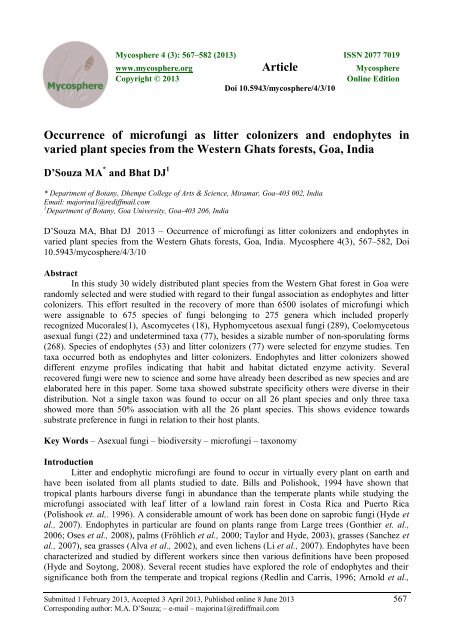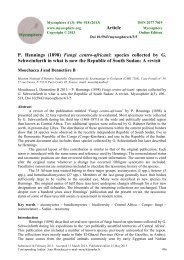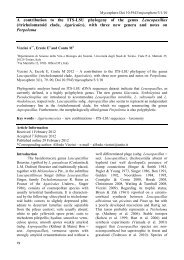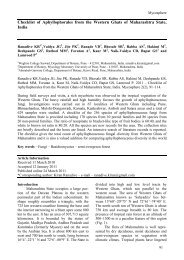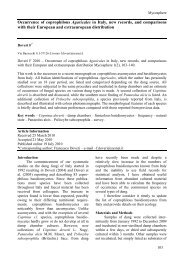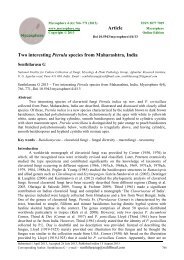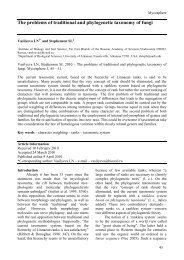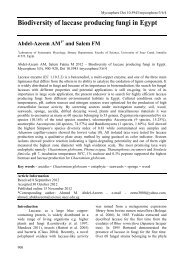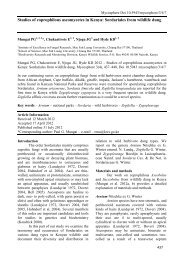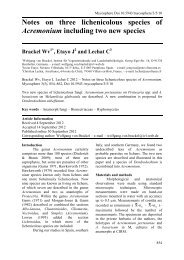View PDF - Mycosphere-online journal
View PDF - Mycosphere-online journal
View PDF - Mycosphere-online journal
Create successful ePaper yourself
Turn your PDF publications into a flip-book with our unique Google optimized e-Paper software.
<strong>Mycosphere</strong> 4 (3): 567–582 (2013) ISSN 2077 7019<br />
www.mycosphere.org Article <strong>Mycosphere</strong><br />
Copyright © 2013<br />
Online Edition<br />
Doi 10.5943/mycosphere/4/3/10<br />
Occurrence of microfungi as litter colonizers and endophytes in<br />
varied plant species from the Western Ghats forests, Goa, India<br />
D’Souza MA * and Bhat DJ 1<br />
* Department of Botany, Dhempe College of Arts & Science, Miramar, Goa-403 002, India<br />
Email: majorina1@rediffmail.com<br />
1 Department of Botany, Goa University, Goa-403 206, India<br />
D’Souza MA, Bhat DJ 2013 – Occurrence of microfungi as litter colonizers and endophytes in<br />
varied plant species from the Western Ghats forests, Goa, India. <strong>Mycosphere</strong> 4(3), 567–582, Doi<br />
10.5943/mycosphere/4/3/10<br />
Abstract<br />
In this study 30 widely distributed plant species from the Western Ghat forest in Goa were<br />
randomly selected and were studied with regard to their fungal association as endophytes and litter<br />
colonizers. This effort resulted in the recovery of more than 6500 isolates of microfungi which<br />
were assignable to 675 species of fungi belonging to 275 genera which included properly<br />
recognized Mucorales(1), Ascomycetes (18), Hyphomycetous asexual fungi (289), Coelomycetous<br />
asexual fungi (22) and undetermined taxa (77), besides a sizable number of non-sporulating forms<br />
(268). Species of endophytes (53) and litter colonizers (77) were selected for enzyme studies. Ten<br />
taxa occurred both as endophytes and litter colonizers. Endophytes and litter colonizers showed<br />
different enzyme profiles indicating that habit and habitat dictated enzyme activity. Several<br />
recovered fungi were new to science and some have already been described as new species and are<br />
elaborated here in this paper. Some taxa showed substrate specificity others were diverse in their<br />
distribution. Not a single taxon was found to occur on all 26 plant species and only three taxa<br />
showed more than 50% association with all the 26 plant species. This shows evidence towards<br />
substrate preference in fungi in relation to their host plants.<br />
Key Words – Asexual fungi – biodiversity – microfungi – taxonomy<br />
Introduction<br />
Litter and endophytic microfungi are found to occur in virtually every plant on earth and<br />
have been isolated from all plants studied to date. Bills and Polishook, 1994 have shown that<br />
tropical plants harbours diverse fungi in abundance than the temperate plants while studying the<br />
microfungi associated with leaf litter of a lowland rain forest in Costa Rica and Puerto Rica<br />
(Polishook et. al,. 1996). A considerable amount of work has been done on saprobic fungi (Hyde et<br />
al., 2007). Endophytes in particular are found on plants range from Large trees (Gonthier et. al.,<br />
2006; Oses et al., 2008), palms (Fröhlich et al., 2000; Taylor and Hyde, 2003), grasses (Sanchez et<br />
al., 2007), sea grasses (Alva et al., 2002), and even lichens (Li et al., 2007). Endophytes have been<br />
characterized and studied by different workers since then various definitions have been proposed<br />
(Hyde and Soytong, 2008). Several recent studies have explored the role of endophytes and their<br />
significance both from the temperate and tropical regions (Redlin and Carris, 1996; Arnold et al.,<br />
Submitted 1 February 2013, Accepted 3 April 2013, Published <strong>online</strong> 8 June 2013 567<br />
Corresponding author: M.A. D’Souza; – e-mail – majorina1@rediffmail.com
2000; Arnold, 2007; Suryanarayan and Kumaresan, 2000; D’Souza and Bhat, 2007). Similarly<br />
there are reviews on fungal endophytes adding to our knowledge on endophytes (Ghimire and<br />
Hyde, 2004; Hyde and Soytong, 2008). Fungi can decompose complex carbon and nitrogen<br />
compounds such as cellulose, hemicellulose, lignin, pectins, proteins, humic acids, and many other<br />
substances, by releasing of extracellular enzymes (Jennings, 1989, 1995; Kjøller & Struwe, 1992;<br />
Moore-Landecker, 1996). According to Bills, 1995 and Bills, 1996 tropical forests are the ‘black<br />
box’ with respect to our knowledge on diversity and distribution of microfungi and would offer<br />
new and exciting opportunities for all interested in fungal ecology, taxonomy and biotechnology.<br />
With this view the present study was therefore undertaken to document both the litter and<br />
endophytic mycota associated with monocotyledonous and dicotyledonous plant species from the<br />
Western Ghats forests in Goa, India, their substrate specificity with regards to the host plants and to<br />
determine the significance of the isolated fungal strains with regard to production of enzymes.<br />
Materials and Methods<br />
Two types of samplings were done during this study.<br />
(i) For taxonomy and diversity study of the litter and endophytic fungi,<br />
sampling materials of both dicotyledonous and monocotyledonous plants were randomly gathered<br />
from different sites in the forest. In the first category, aimed at documentation of fungal diversity of<br />
the region, specimens of twenty six several widely distributed native dicotyledonous and<br />
monocotyledonous plant species were randomly gathered from forests of places such as Alorna,<br />
Baga, Bondla, Chorlem, Cotigao, Molem, Taleigao and Tambisurla of Goa state and were scanned<br />
for litter inhabiting (epiphytic) and endophytic fungi i.e. Bambusa arundinacea (Retz.)Willd.,<br />
Bauhinia purpurea Linn., Calamus thwaitesii Becc. Ex Hook., Caryota urens Linn., Curcuma<br />
decipens Dalz., Dellenia indica Linn., Dendrocalamus strictus (Roxb.) Nees, Hydnocarpus<br />
laurifolia (Dennst.) Sleumer, Terminalia paniculata Roth., Elaeis guineensis Jacq., Ensete<br />
superbum (Roxb.) Cheesman, Ficus religiosa Linn., Ficus benghalensis Linn., Ficus tinctorius var.<br />
parasitica (Willd.) Corner, Flacourtia montana Graham, Helictris ixora Linn., Ixora brachiata<br />
Roxb., Mangifera indica Linn., Pandanus tectorius Soland. Ex Parkinson, Psychotria dalzelli Hk.f.,<br />
Sageraea laurifolia (Grah.) Blatter, Syzygium cumini (Linn.) Skeels, Tectona grandis Linn., Xylia<br />
xylocarpa (Roxb.) Taub., Zanthoxylum rhetsa (Roxb.) DC., and Sanseiviera zeylanica Willd.<br />
(ii) In the second, aimed at elucidation of seasonal occurrence of fungi,<br />
samples of four pre-determined plants were gathered from two defined localities, Bondla and<br />
Molem, at regular seasonal intervals, over a period of two years. Seasonal studies were carried out<br />
during the pre-monsoon, monsoon and post-monsoon season with following native dicotyledonous<br />
and monocotyledonous plant species, one plant each from Bondla and Molem wildlife sanctuaries.<br />
A. Bondla wildlife Sanctuary:<br />
Dicotyledonous representative:<br />
Monocotylednous plant:<br />
B. Molem wildlife Sanctuary:<br />
Dicotyledonous representative:<br />
Monocotylednous plant:<br />
Saraca asoca (Roxb.) De Wilde<br />
Calamus thwaitesii Becc.<br />
Careya arborea Roxb.<br />
Dendrocalamus strictus (Roxb.) Nees<br />
The sampling locations are indicated in Fig. 1. The two sites of seasonal study are well recognized<br />
sanctuaries stretched along the Western Ghats in Goa State. The Bondla Wildlife Sanctuary, an area<br />
of 8 sq.km and smaller of the two, is located about 55 km north-east of Goa University campus.<br />
The vegetation in the region is largely moist deciduous with small patches of evergreen trees<br />
covered by stranglers, lianas and canes. The Molem Wildlife Sanctuary, about 240 sq. km area<br />
along the eastern side of the State, is the largest sanctuary in Goa. The vegetation ranged from<br />
moist-deciduous and semi-evergreen to evergreen type. At several places in the sanctuary one<br />
would notice good under storey cover of shrubs.<br />
568
Fig. 1 – Map showing the sampling sites<br />
Being in the tropical belt and proximity of the west coast, ambient temperature of the<br />
collection sites in the Western Ghats in Goa state always ranged between 22-35 0 C, the temperature<br />
seldom falling below 16 0 C. Mean annual rainfall along the ghats was 220-300 cm and humidity<br />
ranged between 60-90%.<br />
The sampling materials included the following:<br />
a) Senescent or dried leaves fallen to the ground and exposed to a prolonged time of decay. These<br />
leaves were generally blackish brown, brittle and sometimes had no interveinal laminar regions.<br />
b) Dead and decaying, fallen twigs, culms, spathe, etc., and<br />
c) Intact fresh, green, disease free and healthy leaves, twigs etc.<br />
569
The leaf litter, twigs and live leaves, twigs were sampled out at random during the study<br />
period and analyzed for litter and endophytic fungi. The samples were transported to the laboratory<br />
in fresh polythene bags and stored in a refrigerator at 4 0 C until they were processed.<br />
Isolation Methods<br />
In the studies of litter and phylloplane fungi, simultaneous use of more than one isolation<br />
techniques has been found advantageous in the understanding of microbial population (Dickinson,<br />
1976; Dickinson and Wallace, 1976; Hyde and Soytong, 2008). A combination of various<br />
conventional (e.g., moist chamber, particle plating) and molecular techniques appears to be the<br />
more promising approach for characterizing the fungal community structure and for filling the gaps<br />
in our knowledge of the contribution of fungal groups to the decomposition of leaves in a forest<br />
ecosystem. In the present study, two kinds of isolation techniques, namely ‘moist chamber<br />
incubation’ (Hawksworth, 1974) and ‘particle-plating’ (Bills and Polishook, 1994) methods were<br />
used in order to accomplish maximum recovery of litter fungi associated with the plant substrate.<br />
The endophytic fungi were isolated by employing ‘3-step surface sterilization process’ elaborated<br />
by Petrini and Fisher (1986). Incubation was done at 22-25 0 C and fungi were isolated on 2% MEA<br />
plates, a general medium commonly used in endophyte studies (Arnold, 2000) and known to yield<br />
large number of endophytic isolates and species relative to other media (Frohlich & Hyde, 1999).<br />
Isolations were carried out at room temperature with the help of a stereoscope fitted with an<br />
incident light. The fungal colonies emerging out from the litter particles and leaf or twig segments<br />
in the isolation plates were counted as ‘colony forming units’(CFU). Each such isolated distinct<br />
fungal colony was considered as a ‘morphotype’. The isolates were grouped into sporulating and<br />
non-sporulating forms. Sporulating structures were considered as diagnostic characters in the<br />
identification of fungi. Semi-permanent slides of sporulating structures from the colonies were<br />
prepared using water or lactophenol cotton blue as mountant (Hawksworth, 1974). Illustrations of<br />
the fungi were made using a camera-lucida drawing tube attached to a binocular microscope<br />
(Olympus Make). Photomicrographs were taken using an automatic camera fitted to a bright-field<br />
research microscope (Nikon Make). Using standard taxonomic keys and monographs, (Ellis, 1971;<br />
Ellis, 1976; Sutton, 1980; Matsushima, 1971; Matsushima, 1975), the isolates were identified and<br />
assigned to respective genera and species. In the absence of sporulation, the taxonomic identity of<br />
several non-sporulating forms recovered is not known at this moment and they are recognized<br />
merely based on cultural characters such as colony morphology, growth rate and pigmentation. For<br />
enzyme assays, the methods prescribed by Carder (1986) for amylase and Hankin and<br />
Anagnostakis (1975) for cellulose and pectinase were followed.<br />
Data Analysis<br />
The relative frequency was calculated using the formula, (R f =n/N x 100, where n=number<br />
of fungal colonies of one species in a collection, N= total number of fungal colonies of all species<br />
in the same collection). The mean density of colonization of a single endophyte species was<br />
calculated by method of Fisher and Petrini (1987), [i.e. the number of colonized segments divided<br />
by the total number of segments plated x 100]. In case of seasonal occurrence of microfungi,<br />
Jaccard Similarity Coefficients were calculated for all possible pairs of hosts to compare the<br />
endophyte assemblages, according to the following formula.<br />
Similarity coefficient = C/ (A+B+C),<br />
Where A and B are the total number of fungal species isolated from any two hosts and C the<br />
number of fungal species found in common (Sneath and Sokal, 1973). The results were expressed<br />
in percentages.<br />
In order to analyze the enzyme activity, Euclidean distance average linkage method of<br />
cluster analyses using Systat 5.1 was used.<br />
570
Results<br />
Biodiversity<br />
In the present study, investigation on microfungi occurring in association with 30<br />
monocotyledonous and dicotyledonous native plants (Tables 1, 2) of forests of Western Ghats in<br />
Goa was carried out over a period of two years following moist-chamber incubation, particleplating<br />
and endophyte isolation techniques. The exercise resulted with recovery of more than 6500<br />
isolates of microfungi. These were assignable to 675 taxa of fungi belonging to 275 genera which<br />
included properly recognized Mucorales (1), Ascomycetes (18), asexual hyphomycetes (289),<br />
asexual coelomycetes (22) and undetermined taxa (77), besides a sizable number of nonsporulating<br />
forms (268).<br />
In case of diversity study, with regard to 26 plants species studied, the study resulted with<br />
recovery of 388 microfungi. They belonged to major taxonomic groups such as asexual<br />
hyphomycetes (224), Ascomycetes (14), asexual coelomycetes (20), besides non-sporulating<br />
morphotypes (130). In case of seasonal studies, in all, a total of 4461 isolates distinguishable into<br />
402 taxa of litter and endophytic fungi belonging to Zygomycetes (1), Ascomycetes (12), asexual<br />
coelomycetes (14), asexual hyphomycetes (209) and non-sporulating forms (166) were recovered.<br />
As can be seen from diversity and seasonal study, hyphomycetous asexual fungi are largest group<br />
along with sizeable number of non-sporulating forms. Amongst the fungi brought into pure culture,<br />
some fungi did not sporulate and these were considered here as ‘non-sporulating morphotypes’<br />
(NSM) based on cultural characters such as colour, shape, growth rate and presence and absence of<br />
exudates in the colony. In the absence of any sporulating structures the taxonomy of these forms<br />
also remained undetermined. Taxonomic details are given in Table 1 & Table 2. In the descending<br />
order of abundance, the fungi associated with plant species were in this order: asexual<br />
hyphomycetous asexual fungi and non-sporulating forms (maximum) and coelomycetous sexual<br />
fungi and ascomycetes (minimum). It is evident from the results that fungi belonging mainly to<br />
hyphomycetous asexual group and non-sporulating forms were the major colonizers of the litters of<br />
plant species as exhibited by their species abundance. Of the plants studied, in monocotyledons, the<br />
recovery percent ratio of hyphomycetous asexual fungi was 88% and non-sporulating forms 12%.<br />
In dicotyledonous plants, the recovery percent ratio of hyphomycetous asexual fungi and nonsporulating<br />
forms was 70:30.<br />
In order to compare the similarity of species composition of fungi between host plants, the<br />
data on number of fungal species recovered from each plant was subjected to Jaccard’s similarity<br />
coefficient analysis. The Jaccard’s similarity coefficient showed that the composition of fungi<br />
recovered from two plant species, i.e. Calamus thwaitesii and Saraca asoca did not overlap by<br />
more than 27.05% and the other two plant species, i.e. Careya arborea and Dendrocalamus strictus<br />
by 21.19%, though these plants, i.e. Calamus thwaitesii and Saraca asoca in Bondla wildlife<br />
sanctuary and Careya arborea and Dendrocalamus strictus in Molem wildlife sanctuary, lie in<br />
proximity to each other and were practically exposed to the same environmental conditions and<br />
fungal inoculums. (Table 4).<br />
Table 1 Fungi isolated from four plants during seasonal study<br />
Plant species Mucorales Ascomycete Coelomycete Anamorphic Nonsporulating<br />
Li En Li En Li En Li En Li En<br />
Saraca asoca 0 0 6 4 9 6 63 10 50 11<br />
Calamus thwaitesii 0 0 4 2 6 3 87 12 39 10<br />
Careya arborea 1 0 6 2 12 2 82 4 43 19<br />
Dendrocalamus<br />
strictus<br />
0 0 2 2 4 1 82 13 52 14<br />
(Note: Substrates: Li- Leaf-litter; En-Endophyte)<br />
571
Substrate specificity<br />
Generally, different plant species have a different chemical composition, and this may affect<br />
the microbial community composition and biomass. As can be seen from the results, it is evident<br />
that a diverse and large number of microfungi were isolated from different plant substrates. Some<br />
fungi showed substrate specificity others were diverse in their distribution.<br />
With regard to plant substrate, live or dead, the number of fungi (both litter inhabiting and<br />
endophytes) appeared were common to most of the plant species studied while a few were<br />
restricted to specific plants. Not a single fungus was found to occur in all the 26 plant species<br />
scanned. Amongst the fungi recorded, only three showed more than 50% association with plant<br />
species. That is, Cladosporium herbarum was found to occur on 20 plant species, viz.<br />
Dendrocalamus strictus, Bambusa arundinacea, Bauhinia purpurea, Calamus thwaitesii, Caryota<br />
urens, Curcuma decipens, Dellenia indica, Hydnocarpus laurifolia, Elaeis guineensis, Ficus<br />
religiosa, Ficus benghalensis, Flacourtia montana, Helictris ixora, Ixora brachiata, Mangifera<br />
indica, Psychotria dalzelli, Syzygium cumini, Tectona grandis, Xylia xylocarpa and Zanthoxylum<br />
rhetsa whereas Vermiculariopsiella elegans was common to the 17 plants: Bambusa arundinacea,<br />
Bauhinia purpurea, Calamus thwaitesii, Curcuma decipens, Dendrocalamus strictus, Elaeis<br />
guineensis, Ensete superbum, Flacourtia Montana, Ficus religiosa, Ficus benghalensis, Helictris<br />
ixora, Hydnocarpus laurifolia, Mangifera indica, Pandanus tectorius, Psychotria dalzelli,<br />
Sanseiviera zeylanica and Zanthoxylum rhetsa. Cochcliobolus lunatus was common to following<br />
17 plants: Bambusa arundinacea, Calamus thwaitesii, Caryota urens, Dendrocalamus strictus,<br />
Ensete superbum, Ficus tinctorius var. parasitica, Ficus religiosa, Helictris ixora, Hydnocarpus<br />
laurifolia, Mangifera indica, Pandanus tectorius, Psychotria dalzelli, Syzygium cumini, Tectona<br />
grandis and Zanthoxylum rhetsa.<br />
The following fungi showed more than 50% association with the plants studied:<br />
Cladosporium herbarum (84.61%), Cochliobolus lunatus (65.38%) and Vermiculariopsiella<br />
elegans (65.38%). It may be inferred that these plants are major substrate or hosts for the fungi. The<br />
fungi such as Acremonium sp.1, Cladosporium cladosporoides, Cylindrocladium sp., Dactylella<br />
sp., Dictyochaeta assamica, Fusarium decemcellulare, Fusarium solani, Idriella lunata,<br />
Penicillium sp. Trichoderma lignorum and Undetermined Ascomycete sp. 3 showed association<br />
with less than 50% of the plants studied.<br />
The common and exclusive genera found in the plant species are listed in the Fig. 2 and<br />
Table 3.<br />
As seen in Fig 2, a few of the fungi recovered were isolated more than once but from the<br />
same plant and some were found to occur on more than one plant species during the course of study<br />
period. It has been observed that these fungi were specific to the plant host and did not occur on<br />
any other plants. It may be presumed that these fungi do not colonize other plants and their<br />
occurrence is limited to only one or a few plant species. Such substrate specificity in plants by<br />
fungi was predicted by Boddy and Griffith (1989); Whalley (1993); Zhou and Hyde, 2001 and the<br />
results presented here were in conformity.<br />
New described fungi<br />
Several recovered fungi were new to science and have been already described as new<br />
species. i.e.<br />
1. Aquaphila ramdayalea Maria et Bhat sp. nov., Kumbhamaya goanensis Maria et Bhat sp.<br />
nov. (DSouza and Bhat, 2001)<br />
2. Bharatheeya gen.nov., Bharatheeya goanensis (Bhat and Kendrick) D’Souza and Bhat.<br />
comb.nov., Bharatheeya mucoidea sp. nov (DSouza and Bhat, 2002)<br />
3. Kramasamuha kamalensis Maria et Bhat sp. nov. (Maria and Bhat, 2002)<br />
4. Didymobotryum spirillum D’Souza et Bhat sp. nov. (D’Souza and Bhat, 2002)<br />
5. Trichobotrys ramosa Maria et Bhat sp. nov. (DSouza and Bhat, 2001)<br />
6. Vermiculariopsiella elegans sp. nov. and Vermiculariopsiella inidica sp. nov.<br />
(Keshavaprasad et. al., 2003)<br />
572
7. Pleurophragmium indicum M. A. D’Souza & Bhat, sp. nov. (Maria A. D’Souza & D.J.<br />
Bhat, 2012)<br />
Fig. 2 – Occurrence of fungi on plant species<br />
Table 2 Fungi isolated from different dicotyledonous and monocotylednous plants during the<br />
diversity study:<br />
Plant species Abbr. Ascomycete Coelomycete Anamorphic Non-sporulating<br />
Li En Li En Li En Li En<br />
Dendrocalamus strictus Dst. (M) 1 3 1 0 28 4 6 1<br />
Bambusa arundinacea Bar. (M) 0 3 1 0 14 3 7 2<br />
Bauhinia purpurea Bpu. (D) 0 0 5 1 21 3 11 10<br />
Calamus thwaitesii Cth. (M) 0 2 1 1 11 3 8 1<br />
Caryota urens Cur. (M) 3 0 2 0 13 1 7 6<br />
Curcurma decipens Cde. (M) 2 1 3 1 12 7 9 5<br />
Dillenia indica Din. (D) 0 2 1 1 13 0 16 5<br />
Hydnocarpus laurifolia Hla. (D) 1 2 0 0 14 3 0 4<br />
Terminalia paniculata Tpa. (D) 1 1 1 0 17 2 7 5<br />
Elaeis guineensis Egu. (M) 4 0 4 4 33 9 23 10<br />
Ensete superbum Esu. (M) 0 2 1 2 11 2 4 3<br />
Ficus religiosa Fre. (D) 0 1 0 2 16 2 1 3<br />
Ficus benghalensis Fbe. (D) 0 0 0 2 23 3 10 1<br />
Ficus tinctorius var. Fti.(D) 2 2 3 1 26 1 17 14<br />
Parasitica<br />
Flacourtia montana Fmo.(D) 4 1 2 0 18 2 9 2<br />
Helictris ixora Hix. (D) 2 1 1 0 14 3 10 9<br />
Ixora brachiata Ibr. (D) 0 0 1 0 16 21 4 4<br />
Mangifera indica Min. (D) 0 1 0 2 12 2 6 2<br />
Pandanus tectorius Pte. (M) 0 3 0 0 16 4 24 3<br />
Psychotria dalzellii Pda. (D) 1 2 1 0 14 1 10 4<br />
Sageraea laurifolia Sla. (D) 1 1 0 0 21 0 3 6<br />
Syzygium cumini Scu. (D) 2 1 3 5 36 6 17 9<br />
Tectona grandis Tgr. (D) 0 3 2 2 12 5 25 10<br />
Xylia xylocarpa Xxy.(D) 0 0 3 0 22 2 15 3<br />
Zanthoxylum rhetsa Zrh. (D) 4 3 1 0 16 3 8 5<br />
Sanseiviera zeylanica Sze. (M) 1 0 0 0 16 2 8 6<br />
(Note: Substrates: M-Monocot; D-Dicot; Li- Leaf-litter; En-Endophyte)<br />
573
Enzyme Studies<br />
One hundred and forty species of the litter and endophytic fungi isolated from four test<br />
plants, namely, Saraca asoca and Careya arborea (Dicotyledonous plant) and Calamus thwaitesii<br />
and Dendrocalamus strictus (Monocotyledonous plant), were screened in order to test their ability<br />
to produce at least 3 common enzymes, i.e. amylase, cellulose and pectinase. Of the fungi tested, 10<br />
species were common to both litter and live plant substrates whereas some were either litter<br />
inhabiting (67) or endophytic (53) in their substrate relationship.<br />
The results showed that 61 taxa of fungi were positive for amylase (43.57%), 69 for<br />
cellulose (49.28%) and 60 for pectinase (42.85%) activity. Twenty four species exhibited ability to<br />
produce all the enzymes (17.14%) whereas a few were found to produce exclusively a particular<br />
enzyme, i.e. 13 isolates were amylase positive (9.28%), 18 cellulolytic (12.86%) and 23 with<br />
pectinolytic activity (16.43%). Of the 24 taxa with ability to produce all the 3 enzymes,<br />
Corynespora sp.2, Corynespora sp.3 and Pestalotiopsis sp. showed highest activity in terms of<br />
‘zone of clearance’. Interestingly both these isolates were endophytes.<br />
Some of the fungi which occurred both as litter and endophytes have shown interesting<br />
results. (i) Alternaria alternata recovered as an endophyte and litter inhabitant in Saraca asoca<br />
exhibited different enzymatic activity; the endophyte derivative was pectinolytic whereas the litter<br />
fungus was positive for amylase. (ii) Bharatheeya mucoidea from Calamus thwaitesii as a litter<br />
fungus showed positiveness for both amylase and cellulose with significant quantitative difference<br />
and further as an endophyte exhibited ability to produce only cellulose. (iii) Exactly similar<br />
behavior was shown by Corynespora sp.1 isolated as litter and endophyte fungus, wherein the<br />
endophyte showed amylase, cellulose and pectinase activity though of lower level and litter isolates<br />
showed positiveness for cellulase. (iv) One more example can be cited with Fusarium solani from<br />
the same plant behaving differently in enzyme activity. The litter isolate was positive for amylase<br />
and cellulase whereas the endophyte showed both amylase and pectinase activity. It may be<br />
inferred that it is a unique phenomenon with Calamus thwaitesii exhibiting distinct substrate<br />
specificity in enzyme activity of inhabiting fungi. It is also evident from the study (Table 5) that<br />
same species or morphotype when isolated from different plants always behaved differently in their<br />
enzyme activity.<br />
The relationship between the fungi studied producing different enzymes was analysed by<br />
employing Cluster Analysis (Systat version 5.0) and subjecting the data to ‘Euclidean distance<br />
average linkage method’ (Fig. 3). The result showed that the fungi producing cellulase and amylase<br />
were closer compared to pectinase. Similar results were obtained by Miriam (2000) in her studies<br />
with 60 isolates of fungi obtained from litter and endophytic substrates of Ficus benghalensis and<br />
Carissa congesta.<br />
Fig. 3 – Euclidean distance average linkage method<br />
574
Table 3 Exclusive genera of microfungi present in the plant species studied<br />
Name of the fungus<br />
Aquaphila ramdayalea<br />
Clonostachys cylindrospora<br />
Dictyoarthrinium rabaulense<br />
Dictyosporium elegans<br />
Kumbhamaya goanensis<br />
Kumbhamaya indica<br />
Pseudobeltrania sp.<br />
Trichobotrys ramosa<br />
Zalerion curcumensis<br />
Name of plant species<br />
Flacourtia montana<br />
Syzygium cumini<br />
Dendrocalamus strictus<br />
Elaeis guineensis<br />
Flacourtia montana<br />
Dendrocalamus strictus<br />
Bauhinia purpurea<br />
Dendrocalamus strictus<br />
Curcuma decipens<br />
An effort was made to analyse the ability of fungi to produce each enzyme qualitatively by<br />
observing the clearance zone exhibited by the isolates when grown on enzyme-specific medium.<br />
With regard to amylase, the following fungi showed comparatively significant activity by clearance<br />
zone measuring more than 1.3cm; Corynespora sp.2 (1.6cm), Pestalotiopsis sp. (1.5cm), NSM<br />
(1.6cm) and Undetermined species 3 (1.8 cm). As of cellulase, none of the fungi tested showed<br />
significant activity as exhibited by clearance zone measuring more than 1.3 cm. However moderate<br />
activity was exhibited by Corynespora sp.1 (1.1cm) and Scolecobasidium variable (1.0cm). The<br />
following fungi exhibited pectinolytic activity as exhibited by clearance zone: Cladosporium sp. 9<br />
(1.3cm), Trichothecium sp. (1cm), NSM 19(1.3cm), NSM 25 (1.2cm) and NSM 31(1.3cm).<br />
Discussion<br />
Being one of the megadiversity zones of the world, the forest wealth of Western Ghats have<br />
become a matter of considerable interest in the recent days especially the floristic composition.<br />
While the higher plant flora of Goa has been worked out in detail (Rao, 1986), there are noteworthy<br />
hitherto biodiversity records of terrestrial microfungi from this region (Bhat and Kendrick, 1993;<br />
Miriam, 2000; Miriam and Bhat, 2000; Sreekala, 2002, Maria, 2002, Gawas, 2006). This present<br />
study is an in-depth and comprehensive elucidation of terrestrial mycota of widely distributed plant<br />
species from the forests of Goa.<br />
Some of the workers like Hawksworth, 1991; Subramanian, 1992; Isaac et.al; Rossman,<br />
1994; Bills, 1996; Bills and Polishook, 1994 posed some pertinent questions on species abundance<br />
and diversity which remained unanswered. These include 1. How many species are likely to be<br />
found by sampling a single tree or several trees? 2. What and which species are likely to inhabit a<br />
particular host plant and what are their relative abundance? With regards to the tropical endophytes<br />
extensive work on endophytes of palms was carried (Rodrigues and Samuels, 1990; Rodrigues,<br />
1994; Taylor et al., 1999; Frohlich et al., 2000) and specifically with regards to Indian subcontinent<br />
(Bhat and Kendrick, 1993; Suryanarayanan and Kumaresan, 2000; Miriam, 2000; Miriam and Bhat,<br />
2000; Srikala, 2002). With the present study, using different isolation techniques, a large number of<br />
fungi could be isolated and brought into pure culture form. It is evident from the results that fungi<br />
belonging to hyphomycetous asexual fungi and non-sporulating forms were the major colonizers of<br />
the litter of plant species as exhibited by their species abundance. Interestingly in the present study<br />
none of the plants scanned were found to be free of endophytes. Similar observations were made on<br />
tropical plants by Rodrigues and Samuels (1990). Fisher et al, 1986, Sieber et al., 1991 and<br />
Rodrigues, 1994 had earlier reported a high magnitude of undetermined taxa of endophytic fungi<br />
from all the plant species studied. The results presented in this paper are in full conformity with this<br />
observation.<br />
575
Table 4 Jaccard Similarity Coefficient for the litter and endophytic fungi from 4 plant species as<br />
expressed in percentage (%)<br />
Plant species Calamus thwaitesii Saraca asoca Careya arborea Dendrocalamus strictus<br />
Calamus thwaitesii 100 27.5 23.48 28.69<br />
Saraca asoca 100 18.93 23.26<br />
Careya arborea 100 21.19<br />
Dendrocalamus<br />
strictus<br />
100<br />
Effort was made in this study to find out the diversity of fungi (litter inhabiting &<br />
endophytes) associated with some of the plant species from the Western Ghat region. A number of<br />
fungi (both litter and endophytes) recovered were found common to most of the plant species<br />
studied while a few were restricted to specific plants. In this study, not a single fungus was found to<br />
occur on all the 30 plant species scanned and only three fungi i.e. Cladosporium herbarum<br />
(84.61%) Cochliobolus lunatus (65.38%) and Vermiculariopsiella elegans (65.38%) however<br />
showed more than 50% association with all the plant species (Fig. 2). It may be inferred that<br />
vascular plants are the major reservoir of fungi in the forest ecosystem. A few of the fungi were<br />
isolated more than once but from the same plant. These were specific to the plant host and did not<br />
occur on any other plants. It may be said that, some of the fungi are limited to only one or a few<br />
plant species. Such substrate specificity in plants expressed by fungi was predicted by Boddy and<br />
Griffith, (1989); Whalley (1993) and the results presented here are in conformity with the earlier<br />
work. A large number of microfungi can be occasionally isolated from a single plant species and<br />
only a few exhibit dominance in each plant.<br />
Enzyme Studies<br />
One hundred and forty species of the litter and endophytic fungi isolated from the four tests<br />
plants were screened for their ability of producing at least 3 common enzymes, amylase, cellulase<br />
and pectinase. The results showed that 17.14% of the species exhibited ability to produce all the<br />
enzymes. Of these, two endophytic forms exhibited highest activity. In general 43.57% were<br />
amylase positive, 49.28% cellulase and 42.85% were pectinase positive. It was also evident that a<br />
few were producing exclusively a particular enzyme.<br />
Some of the fungi which occurred both as litter and endophytes have shown interesting<br />
results. That is, Alternaria alternata behaved differently in its enzyme activity when occurred<br />
separately as an endophyte and litter inhabitant in Saraca asoca. Similarly, Bharatheeya mucoidea<br />
as a litter fungus showed positiveness for both amylase and cellulase with significant qualitative<br />
difference but as an endophyte exhibited ability to produce only cellulase. Similar behavior was<br />
shown by Corynespora sp.1 isolated as litter and endophytic fungus. One more example can be<br />
cited with Fusarium solani from the same plant behaving differently in enzyme activity. The litter<br />
isolate was positive for amylase and cellulase whereas endophyte showed both amylase and<br />
pectinase activity. It may be deduced from this investigation that it is rather a unique phenomenon<br />
of fungi where the enzyme activity is dictated by the habit and habitat.<br />
The ability of mycota to grow over a wide range of temperature, pH, moisture content and<br />
substrates is the reason for their unique survivability in the decomposing litter and live plant parts<br />
and dominance on certain plants. This idea can be taken further to understand the substrate<br />
preference in fungi in relation to their host plants. From the results of enzyme analyses it can be<br />
interpreted that the occurrence of a fungus in a particular habit and habitat dictated the enzyme<br />
activity in that particular fungus.<br />
576
Table 5 Qualitative estimation of enzymatic activity of fungi obtained from four study plants:<br />
Dendrocalamus strictus; L- Leaf-litter; E-Endophyte)<br />
Fungi Substrate Plant sp. Amylolytic activity Cellulolytic Pectinolytic<br />
activity<br />
activity<br />
Acremoniella sp. E Cth. - - -<br />
Acremonium sp. 1 L Sas. + + -<br />
Acremonium sp. 2 L Cth. ++ - +<br />
Acremonium sp. 3 L Sas. + + -<br />
Acremonium sp. 4 L Car. - + -<br />
Alternaria alternata E Sas. - - +<br />
Alternaria alternata L Sas. + - -<br />
Ascomycete sp.3 Iso-1 E Sas. - - -<br />
Ascomycete sp.4 E Car. ++ + -<br />
Ascomycete sp.3 Iso-2 E Car. - - -<br />
Bharatheeya mucoidea L Cth. +++ + -<br />
Bharatheeya mucoidea E Cth. - ++ -<br />
Cladosporium sp. 1 L Sas. + + -<br />
Cladosporium herbarum L Cth. + + +<br />
Cladosporium herbarum E Cth. + + +<br />
Cladosporium sp. 2 L Sas. - - -<br />
Cladosporium sp. 3 L Sas. + + -<br />
Cladosporium cladosporoides E Den. + + +<br />
Cladosporium cladosporoides L Cth. + + +<br />
Cladosporium sp. 4 L Sas. - + -<br />
Cladosporium sp. 5 L Sas. - - -<br />
Cladosporium sp. 6 L Cth. ++ + +<br />
Cladosporium sp. 7 L Car. - + -<br />
Cladosporium sp. 8 L Den. + + -<br />
Cladosporium sp.9 L Car. + + +++<br />
Cochliobolus lunatus Iso-1 E Car. - ++ ++<br />
Cochliobolus lunatus Iso-1 E Den. - - -<br />
Corynespora sp.1 E Cth. + + +<br />
Corynespora sp.1 L Cth. - ++ -<br />
Corynespora sp.2 E Den. +++ + ++<br />
Corynespora sp.3 E Cth. ++ ++ +<br />
Curvularia lunata E Cth. + - +<br />
Cylindrotrichum sp. E Car. - + -<br />
Cylindrotrichum sp. L Sas. - - -<br />
Dactylella sp. Iso-1 L Cth. + + ++<br />
Dactylella sp. Iso-2 L Sas. + - +<br />
Fusarium decemcellulare E Cth. - - +<br />
Fusarium decemcellulare L Sas. + + -<br />
Fusarium solani L Cth. + + -<br />
Fusarium solani E Cth. + + -<br />
Idriella lunata L Sas. ++ + -<br />
Nigrospora sphaerica E Car. - - +<br />
NSM 1 L Den. - + -<br />
NSM 2 L Den. - + -<br />
NSM 3 L Den. + + +<br />
NSM 4 E Den. + + +<br />
NSM 5 E Car. - - +<br />
NSM 6 E Car. + + +<br />
NSM 7 E Car. ++ + +<br />
NSM 8 E Car. +++ + -<br />
NSM 9 E Car. + + -<br />
NSM 10 E Cth. - - -<br />
NSM 11 E Den. - - -<br />
NSM 12 L Cth. - + -<br />
NSM 13 E Cth. - - -<br />
NSM 14 E Den. + + +<br />
NSM 15 E Den. - + -<br />
NSM 16 E Cth. - + -<br />
NSM 17 E Cth. + + +<br />
NSM 18 L Cth. - + ++<br />
NSM 19 L Cth. - ++ +++<br />
NSM 20 L Cth. ++ + +<br />
NSM 21 E Cth. ++ + +<br />
577
Fungi Substrate Plant sp. Amylolytic activity Cellulolytic<br />
activity<br />
Pectinolytic<br />
activity<br />
NSM 22 E Cth. - + -<br />
NSM 23 L Den. + - -<br />
NSM 24 E Car. + - -<br />
NSM 25 E Car. - - ++<br />
NSM 26 E Car. - + +<br />
NSM 27 E Car. - + +<br />
NSM 28 L Car. - - -<br />
NSM 29 L Car. - - +<br />
NSM 30 L Car. + + -<br />
NSM 31 L Car. - - +++<br />
NSM 32 E Sas. - - ++<br />
NSM 33 E Sas. - - +<br />
NSM 34 L Den. - + -<br />
NSM 35 E Sas. - - -<br />
NSM 36 E Sas. - - +<br />
NSM 37 E Den. + - -<br />
NSM 38 E Sas. - - -<br />
NSM 39 E Sas. - - +<br />
NSM 40 E Sas. - - +<br />
NSM 41 E Sas. - - +<br />
NSM 42 E Sas. + - +<br />
NSM 43 E Sas. - - +<br />
NSM 44 E Sas. - - +<br />
NSM 45 L Cth. - + -<br />
NSM 46 E Sas. - - +<br />
NSM 47 E Sas. - - ++<br />
NSM 48 E Sas. - - -<br />
NSM 49 E Sas. - - -<br />
NSM 50 E Sas. - - +<br />
NSM 51 E Sas. - - -<br />
NSM 52 E Sas. - - +<br />
NSM 53 E Sas. - - +<br />
NSM 54 L Sas. - - -<br />
NSM 55 L Sas. ++ + -<br />
NSM 56 L Den. - - -<br />
NSM 57 L Sas. - - -<br />
NSM 58 L Sas. + - -<br />
NSM 59 L Sas. ++ - -<br />
NSM 60 L Sas. + + +<br />
NSM 61 L Sas. - + -<br />
NSM 62 L Sas. - - -<br />
NSM 63 L Den. - + +<br />
NSM 64 L Sas. - - -<br />
NSM 65 L Sas. + - -<br />
NSM 66 L Den. - + -<br />
NSM 67 L Sas. - - -<br />
NSM 68 L Sas. ++ + -<br />
NSM 69 L Den. - + -<br />
NSM 70 L Den. - - -<br />
NSM 71 L Sas. ++ - -<br />
Penicillum sp.1 L Cth. + + +<br />
Penicillum sp.1 E Den. - - -<br />
Periconia byssoides L Den. + + +<br />
Pestalotiopsis sp. E Car. +++ + +<br />
Pestalotiopsis sp. L Sas. - + -<br />
Pycnidial fungus L Car. + - -<br />
Scolecobasidium constrictum L Car. - - -<br />
Iso-1<br />
Scolecobasidium constrictum L Cth. - - +<br />
Iso-2<br />
Scolecobasidium constrictum L Cth. + - -<br />
Iso-3<br />
Scolecobasidium variable L Cth. - ++ -<br />
Stachybotrys nephrospora L Cth. ++ + -<br />
Trichothecium sp. L Cth. - + ++<br />
Undetermined sp. 1 L Den. - - -<br />
Undetermined sp. 2 L Sas. - - -<br />
578
Fungi Substrate Plant sp. Amylolytic activity Cellulolytic<br />
activity<br />
Pectinolytic<br />
activity<br />
Undetermined sp. 3 L Den. +++ - -<br />
Undetermined sp. 4 E Sas. - - +<br />
Undetermined sp. 5 L Sas. - - -<br />
Undetermined sp. 6 E Cth. - ++ -<br />
Undetermined sp. 7 E Den. + - +<br />
Undetermined sp. 8 L Cth. + + -<br />
Undetermined sp. 9 E Cth. + + ++<br />
Undetermined sp. 10 L Car. + - -<br />
Undetermined sp. 11 L Car. + + ++<br />
Undetermined sp. 12 L Car. ++ - -<br />
Undetermined sp. 13 L Sas. ++ + -<br />
Veronaea sp. L Den. - - -<br />
Wiesneriomyces javanicus L Sas. + - -<br />
Note: The activity of enzyme as denoted by the clearance zone in cm:<br />
0.1 – 0.6 = + Low activity; 0.7 – 1.2 = ++ Moderate activity; 1.3 - 2.0 = +++ Good Activity; - = No Activity.<br />
(Note: Substrates: Sas. – Saraca asoca; Cth.- Calamus thwaitesii; Car.- Careya arborea; Den.- Dendrocalamus strictus; L- Leaflitter;<br />
E-Endophyte)<br />
Acknowledgements<br />
This work is supported by a research grant to Dr. D. J. Bhat from the Department of Science<br />
and Technology, Government of India, New Delhi. One of the author (MD) is thankful for a<br />
research fellowship from the Department of Science and Technology, New Delhi.<br />
References<br />
Alva P, McKenzie EHC, Pointing SB, PenaMuralla R, Hyde KD 2002 – Do Sea grasses harbour<br />
endophytes? Fungal Diversity Research Series 7, 167–178.<br />
Arnold AE, Maynard Z, Gilbert, GS, Coley PD and Kursar TA 2000 – Are tropical fungal<br />
endophytes hyperdiverse? Ecology Letters 3, 267–274.<br />
Arnold AE 2007 – Understanding the diversity of foliar endophytic fungi: progress, challenges, and<br />
frontiers. Fungal Biology Reviews 21, 51–66.<br />
Bhat DJ and Kendrick B 1993 – Twenty-five new conidial fungi from the Western Ghats and the<br />
Andaman Islands, India. Mycotaxon 49,19–90.<br />
Bills GF 1995 – Analysis of microfungal diversity from a users perspective. Canadian Journal of<br />
Botany 73(1), 33–41.<br />
Bills GF 1996 – Isolation and analysis of endophytic fungal communities from Woody plants. In:<br />
Endophytic fungi in grasses and woody plants. Systematics, ecology and evolution (eds. SC<br />
Redlin and LM Carris). APS Press, St. Paul, Minnesota. 31–65.<br />
Bills GF and Polishook JD 1991 – Microfungi from Carpinus caroliniana. Canadian Journal of<br />
Botany 69, 1477–1482.<br />
Bills GF and Polishook JD 1994 – Abundance and diversity of microfungi in leaf litter of a lowland<br />
rain forest in Costa Rica. Mycologia 86, 187–198.<br />
Boddy L and Griffith GS 1989 – Role of endophytes and latent invasion in the development of<br />
decay communities in sapwood of angiospermous trees. Sydowia 41, 41–73.<br />
Boddy L and Watkinson SC 1995 – Wood decomposition, higher fungi, and their role in nutrient<br />
redistribution. Canadian Journal of Botany 73, 1377–1383.<br />
Carder JH 1986 – Detection and quantitation of cellulase by Congo Red staining of substances in a<br />
cup plate diffusion assay. Anal. Biochem. 153, 75–79.<br />
Carmichael JW, Kendrick B, Conners IL and Sigler L 1980 – Genera of Hyphomycetes. University<br />
of Alberta Press, Edmonton 1–386.<br />
D’Souza M A and Bhat DJ 2001 – A new species of Trichobotrys from the Western Ghat forests,<br />
India. Mycotaxon 80, 105–108.<br />
579
D’Souza MA and Bhat DJ 2001 – Two new hyphomycetes from India. In: Microbes and Plants (ed.<br />
Aruna Sinha) 1–6.<br />
D’Souza MA and Bhat DJ 2002 – Bharatheeya, a new hyphomycete genus from India. Mycotaxon<br />
83, 397–403.<br />
D’Souza MA and Bhat DJ 2002 – Didymobotryum spirillum, a new synnematous hyphomycete<br />
from India. Mycologia 94(3), 535–538.<br />
D’Souza MA and Bhat DJ 2007 – Diversity and abundance of endophytic fungi in four plant<br />
species of Western Ghat forest of Goa, southern India. Kavaka 35, 11–20.<br />
Dickinson CH and Wallace V 1976 – Effect of the late applications of the foliar fungicides on<br />
activity of micro-organisms on winter wheat flag leaves. Trans. Br. Mycol. Soc. 67, 103–<br />
112.<br />
Dickinson CH 1976 – Fungi on the aerial surfaces of higher plants. In: Microbiology of aerial plant<br />
surfaces (eds. CH Dickinson and TF Preece). Academic Press, New York. 293–324.<br />
Ellis MB 1971 – Dematiatous Hyphomycetes Commonwealth Mycological Institute, Kew, Surrey,<br />
England.<br />
Ellis MB 1976 – More Dematiatous Hyphomycetes Commonwealth Mycological Institute, Kew,<br />
Surrey, England.<br />
Frohlich J and Hyde KD 1999 – Biodiversity of palm fungi in the tropics: are global fungal<br />
diversity estimates realistic? Biodiversity Conservation 8, 977–1004.<br />
Frohlich J, Hyde KD and Petrini O 2000 – Endophytic fungi associated with palms. Mycological<br />
Research 104, 1202–1212.<br />
Gary Strobel and Bryn Daisy 2003 – Bioprospecting for Microbial Endophytes and their Natural<br />
products. Microbiology and Molecular Biology Reviews. 67(4), 491–502.<br />
Gawas P 2008 – Studies on diversity, activity and ecology of microfungi associated with some<br />
medicinal plants of Goa region of Western Ghats, India. Ph.D. Thesis. Goa University.<br />
Ghimire SR and Hyde KD 2004 – Fungal endophytes. In: Plant Surface Microbiology (eds. A<br />
Varma, L Abbott, D Werner and R Hampp). Springer Verlag: 281–288.<br />
Gonthier P, Gennaro M and Nicolotti, G 2006 – Effects of water stress on the endophytic mycota of<br />
Quercus robur. Fungal Diversity 21, 69–80.<br />
Hankin L and Anagnostakis SL 1975 – The use of solid media for detection of enzyme production<br />
by fungi. Mycologia 67, 597–607.<br />
Hawksworth DL 1974 – Mycologist’s Handbook. Commonwealth Mycological Institute, Kew,<br />
U.K.<br />
Hawksworth DL 1991 – The fungal dimension of biodiversity: magnitude, significance and<br />
conservation. Mycological Research 95, 641–655.<br />
Hawksworth DL 1997 – The fascination of fungi: exploring fungal diversity. Mycologist. 11, 18–<br />
22.<br />
Hyde KD, Bussaban B, Paulus B, Crous PW, Lee S, Mckenzie EHC, Photita W and Lumyong S<br />
2007 – Biodiversity of saprobic fungi. Biodiversity and Conservation 16, 17–35.<br />
Hyde KD and Soytong K 2008 – The fungal endophyte dilemma. Fungal Diversity. 33, 163–173.<br />
Isaac S, Frankland JC, Watling R and Whalley AJS – 1993 Aspects of tropical mycology.<br />
Cambridge University Press, Cambridge, U.K.<br />
Jennings DH 1995 – Physiology of Fungal Nutrition. Cambridge University Press, New York.<br />
Jennings DH 1989 – Some perspectives on nitrogen and phosphorous metabolism in fungi. In<br />
Boddy, L., R. Marchant & D. J. Read (eds), Nitrogen, Phosphorus and Sulphur Utilisation<br />
by Fungi. Cambridge University Press, Cambridge. 1–31.<br />
Keshavaprasad TS, Maria D, and Bhat DJ 2003 – Vermiculariopsiella Bender: Present Status of<br />
Species Diversity. In: Frontiers of Fungal Diversity in India (Prof. Kamal Festschrift). (eds.<br />
GP Rao, C Manoharachari, DJ Bhat, RC Rajak and TN Lakhanpal). International Book<br />
Distributing Co. Lucknow, India, 503–511.<br />
580
Kjøller A and Struwe S 1992 – Functional groups of microfungi in decomposition. In Caroll, G. C.<br />
& D. T. Wicklow (eds), The Fungal Community: Its Organization and Role in the<br />
Ecosystem, 2nd ed. Marcel Dekker Inc, New York. 619–630.<br />
Li WC, Zhou J, Guo SY and Guo LD 2007 – Endophytic fungi associated with lichens in Baihua<br />
mountain of Beijing, China. Fungal Diversity 25, 69–80.<br />
Maria. AD and Bhat DJ 2002 – Kramasamuha kamalensis, sp. nov. from India. Journal of Basic<br />
and Applied Mycology 1(1), 6–7<br />
Maria AD and Bhat DJ 2012 – A new species of Pleurophragmium from India. Mycotaxon. 119,<br />
477– 482. http://dx.doi.org/10.5248/119.477.<br />
Matsushima T 1971 – Microfungi of Solomon Islands and Papua-New Guinea. Matsushima. Kobe,<br />
Japan.<br />
Matsushima, T. 1975 – Icones Microfungorum A Matsushima Lectorum. Matsushima. Kobe,<br />
Japan.<br />
Mille-Lindblom C, Fischer H and Tranvik LJ 2006 – Litter-associated bacteria and fungi – a<br />
comparison of biomass and communities across lakes and plant species. Freshwater Biology<br />
51, 730–741<br />
Miriam J 2000 – Studies on diversity, ecology and activity of the microfungi associated with Ficus<br />
bengalensis Linn. and Carissa congesta Wight from Goa State. Ph.D. Thesis. Goa<br />
University, India.<br />
Moore-Landecker E 1996 – Fundamental of the Fungi, 4th ed. Prentice-Hall, New Jersey.<br />
Oses R, Valenzuela S, Freer J, Sanfuentes E and Rodriguez J 2008 – Fungal endophytes in xylem<br />
of healthy Chilean trees and their possible role in early wood decay. Fungal Diversity 33,<br />
77–86.<br />
Petrini O and Fisher PJ 1986 – Fungal endophytes in Salicornia perennis. Trans. Br. Mycol. Soc.<br />
87, 647–651.<br />
Petrini O 1986 – Taxonomy of endophytic fungi in aerial plant tissues. In: Microbiology of the<br />
phyllosphere. (eds. NJ Fokkema and J Van den Heuvel). Cambridge University Press.<br />
Cambridge. 175–187.<br />
Rao SS 1986 – Flora of Goa, Diu, Daman, Dadra and Nagarhaveli. Vol. I and II. Botanical Survey<br />
of India, New Delhi.<br />
Redlin SC and Carris LM 1996 – Endophytic Fungi in Grasses and Woody Plants. APS Press,<br />
Minnesota.<br />
Rodrigues KF and Samuels GJ 1990 – Preliminary study of endophytic fungi in tropical palm.<br />
Mycol. Res., 94, 827–830.<br />
Rodrigues KF 1994 – Foliar fungal endophytes of the Amazonian palm Euterpe oleracea.<br />
Mycologia, 86, 376–385.<br />
Rodrigues KF and Petrini KF 1997 – Biodiversity of endophytic fungi in Tropical regions. In:<br />
Biodiversity of Tropical Microfungi. (ed. Hyde, K.D.) Hongkong University Press, Hong<br />
Kong.<br />
Rossman AY 1994 A strategy for an all taxa inventory of Fungal biodiversity and terrestrial<br />
ecosystems. (eds. C.J. Peng and C.H. Chou). Institute of Botany, Academia Sinica No. 14,<br />
169–194.<br />
Sánchez Márquez S, Bills GF and Zabalgogeazcoa I 2007 – The endophytic mycobiota of the grass<br />
Dactylis glomerata. Fungal Diversity 27, 171–195.<br />
Sneath PHA and Sokal RR 1973 – Numerical Taxonomy. W.H. Freeman, San Francisco.<br />
Nair SK 2002 – Studies on Diversity, Ecology and Biology of microfungi from freshwater streams<br />
of Western Ghats in Goa State, India. Ph.D. Thesis. Goa University.<br />
Subramanian CV 1992 – Tropical mycology and biotechnology. Current Science 63, 167–172.<br />
Suryanarayan TS and Kumaresan V 2000 – Endophytic fungi of some halophytes from an estuarine<br />
mangrove forest. Mycological Research 104, 1465–1467.<br />
Sutton BC 1980 The Coelomycetes: Fungi Imperfectii with Pycnidia, Acervuli and Stromata.<br />
Commonwealth Mycological Institute, U.K.<br />
581
Taylor JE and Hyde KD 2003 – Microfungi on Tropical and Temperate Palms. Fungal Diversity<br />
Research Series 12, 1–459.<br />
Whalley AJS 1993 – Tropical Xylariaceae: their distribution and ecological characteristics. In:<br />
Aspects of tropical mycology (eds. S Isaac, JC Frankland, R Watling and AJS Whalley),<br />
Cambridge University Press: Cambridge, U.K. pp. 103–120.<br />
Zhou D and Hyde KD 2001 – Host-specificity, host-exclusivity, and host-recurrence in saprobic<br />
fungi. Mycological Research 105, 1449–1457.<br />
582


